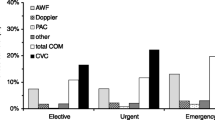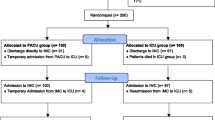Abstract
Background
Intra-operative tachycardia is a common adverse event, often recorded as an indicator for process quality in quality assurance projects in anaesthesia.
Methods
This retrospective study is based on data sets of 28,065 patients recorded with a computerised anaesthesia record-keeping system from 23 February 1999 to 31 December 2000 at a tertiary care university hospital. Cases were defined as patients with intra-operative tachycardia; references were automatically selected according to matching variables (high-risk surgery, severe congestive heart failure, severe coronary artery disease, significant carotid artery stenosis and/or history of stroke, renal failure, diabetes mellitus and urgency of surgery) in a stepwise fashion. Main outcome measures were hospital mortality, admission to the intensive care unit (ICU) and prolonged hospital stay. Differences in outcome measures between the matched pairs were assessed by univariate analysis. Stepwise regression models were developed to predict the impact of intra-operative tachycardia on the different outcome measures.
Results
In our study 474 patients (1.7%) were found to have had intra-operative tachycardia. Matching was successful for 99.4% of the cases, leading to 471 cases and references. The crude mortality rates for the cases and matched references were 5.5% and 2.5%, respectively (P=0.020). Of all case patients, 22.3% were treated in an ICU, compared to 11.0% of the matched references (P=0.001). Hospital stay was prolonged in 25.1% of the patients with tachycardia compared to 15.1% of the matched references (P=0.001).
Conclusions
In this study, patients with intra-operative tachycardia who were undergoing non-cardiac surgery had a greater peri-operative risk, leading to increased mortality, greater frequency of admission to an ICU and prolonged hospital stay.
Similar content being viewed by others
References
Sanborn KV, Castro J, Kuroda M, Thys DM (1996) Detection of intraoperative incidents by electronic scanning of computerised anesthesia records. Comparison with voluntary reporting. Anesthesiology 85:977–987
DGAI-Kommission "Qualitätssicherung und Datenverarbeitung in der Anästhesie" (1993) Kerndatensatz Qualitätssicherung in der Anästhesie. Anästh Intensivmed 34:331–335
Ouchterlony J, Arvidsson S, Sjostedt L, Svardsudd K (1995) Perioperative and immediate postoperative adverse events in patients undergoing elective general and orthopaedic surgery. Acta Anaesthesiol Scand 39:643–652
Cooper JB, Cullen DJ, Nemeskal R, et al (1987) Effects of information feed-back and pulse oximetry on the incidence of anaesthesia complications. Anesthesiology 67:686–694
Benson M, Junger A, Quinzio L, et al (2001) Influence of the method of data collection on the documentation of blood-pressure readings with an anesthesia information management system (AIMS). Methods Inf Med 40:190–195
Cohen MM, Duncan PG, Pope DB, Wolkenstein C (1986) A survey of 112.000 anaesthetics at one teaching hospital (1975–1983). Can Anaesth Soc J 33: 22–31
Rose DK, Cohen MM, DeBoer DP (1996) Cardiovascular events in the postanesthesia care unit: contribution of risk factors. Anesthesiology 84:772–781
Reich DL, Bennett-Guerrero E, Bodian CA, Hossain S, Winfree W, Krol M (2002) Intraoperative tachycardia and hypertension are independently associated with adverse outcome in noncardiac surgery of long duration. Anesth Analg 95:273–277
Lerou JG, Dirksen R, van Daele M, Nijhuis GM, Crul JF (1988) Automated charting of physiological variables in anesthesia: a quantitative comparison of automated versus handwritten anesthesia records. J Clin Monit 4:37–47
Reich DL, Wood RK, Mattar R, et al (2000) Arterial blood pressure and heart rate discrepancies between handwritten and computerised anesthesia records. Anesth Analg 91:612–616
Cook RI, McDonald JS, Nunziata E (1989) Differences between handwritten and automatic blood pressure records. Anesthesiology 71:385–390
Reich DL, Bodian CA, Krol M, Kuroda M, Osinski T, Thys DM (1999) Intraoperative hemodynamic predictors of mortality, stroke, and myocardial infarction after coronary artery bypass surgery. Anesth Analg 89:814–822
Benson M, Junger A, Quinzio L, et al (2000) Clinical and practical requirements of online software for anesthesia documentation: an experience report. Int J Med Inf 57:155–164
Benson M, Junger A, Quinzio L, et al (2000) Data processing at the anesthesia workstation: from data entry to data presentation. Methods Inf Med 39:319–324
Lee TH, Marcantonio ER, Mangione CM, et al (1999) Derivation and prospective validation of a simple index for prediction of cardiac risk of major noncardiac surgery. Circulation 100:1043–1049
van Oostrom J, Gravenstein C, Gravenstein J (1993) Acceptable ranges for vital signs during general anesthesia. J Clin Monit 9:321–325
Schwilk B, Muche R, Treiber H, Brinkmann A, Georgieff M, Bothner U (1998) A cross-validated multifactorial index of perioperative risks in adults undergoing anaesthesia for non-cardiac surgery. J Clin Monit 14:283–294
Junger A, Veit C, Klöss T (1998) Erfahrungsbericht über vier Jahre externe Qualitätssicherung in der Anästhesiologie in Hamburg. Anasthesiol Intensivmed Notfallmed Schmerzther 33:417–424
Goldman L, Caldera DL, Nussbaum SR, et al. (1977) Multifactorial index of cardiac risk in noncardiac surgical procedures. N Engl J Med 297:845–850
Auerbach AD, Goldman L (2002) Beta-blockers and reduction of cardiac events in noncardiac surgery: clinical applications. JAMA 287:1445–1447
Acknowledgement
Statistical analysis was performed in co-operation with Moredata GmbH, Giessen, Germany.
Author information
Authors and Affiliations
Corresponding author
Additional information
Financial support for this study was provided in part by a grant from IMESO GmbH, Hüttenberg, Germany. The founding agreement ensured the authors' independence in designing the study, interpreting the data, and writing and publishing the report
M. B. is a partner of the IMESO GmbH (Hüttenberg, Germany) and employee of the University Hospital of Giessen. None of the other authors or participants has any financial interest in the subject matter, materials, or equipment discussed, or in competing materials
A part of the results has been presented as a lecture at the 50th German Congress of Anaesthesiology (DAC 2003, 9–12 April) in Munich
Rights and permissions
About this article
Cite this article
Hartmann, B., Junger, A., Röhrig, R. et al. Intra-operative tachycardia and peri-operative outcome. Langenbecks Arch Surg 388, 255–260 (2003). https://doi.org/10.1007/s00423-003-0398-y
Received:
Accepted:
Published:
Issue Date:
DOI: https://doi.org/10.1007/s00423-003-0398-y




